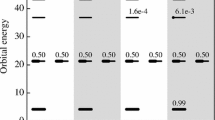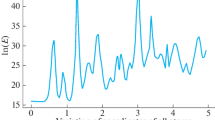Abstract
Optimization methods that use gradients require initial estimates of the Hessian or second derivative matrix; the more accurate the estimate, the more rapid the convergence. For geometry optimization, an approximate Hessian or force constant matrix is constructed from a simple valence force field that takes into account the inherent connectivity and flexibility of the molecule. Empirical rules are used to estimate the diagonal force constants for a set of redundant internal coordinates consisting of all stretches, bends, torsions and out-of-plane deformations involving bonded atoms. The force constants are transformed from the redundant internal coordinates to Cartesian coordinates, and then from Cartesian coordinates to the non-redundant internal coordinates used in the specification of the geometry and optimization. This method is especially suitable for cyclic molecules. Problems associated with the choice of internal coordinates for geometry optimization are also discussed.
Similar content being viewed by others
References
Pulay, P.: in Modern theoretical chemistry, Schaefer III, H. F. Ed., New York: Plenum 1977, Vol. 4
Schlegel, H. B.: Computational theoretical organic chemistry, Csizmadia, I. G., Daudel, R., Eds., Holland: Reidel 1981
Schlegel, H. B.: J. Comput. Chem.3, 214 (1982)
Fletcher, R.: in Numerical methods for unconstrained optimization, Murray, W. Ed., London: Academic Press 1972; Huang, H. Y.: J. Opt. Theory Appl.5, 405 (1970) and refs. cited therein.
Murtagh, B. A., Sargent, R. W.: Comput. J.13, 185 (1970)
Pople, J. A., Krishnan, R., Schlegel, H. B., Binkley, J. S.: Int. J. Quantum Chem. Symp.13, 225 (1979)
Wilson Jr., E. B., Decius, J. C., Cross, P. C.: Molecular vibrations, New York: McGraw-Hill 1955
Badger, R. M.: J. Chem. Phys.2, 128 (1934);3, 227 (1935)
See for example Chapter4 in Johnston, H. S.: Gas phase reaction rate theory. New York: Ronald Press 1966
Binkley, J. S., Whiteside, R. A., Krishnan, R., Seeger, R., DeFrees, D. J., Schlegel, H. B., Topiol, S., Kahn, L. R., Pople, J. A.: GAUSSIAN 80, QCPE13, 406 (1981)
Allinger, N. L., Yuh, Y. H.: MM2: Molecular mechanics II, QCPE13, 395 (1981)
Andose, J. D., Engler, E. E., Collins, J. B., Hummel, J. P., Mislow, K., Schleyer, P. v. R.: BIGSTRAIN: Empirical force field calculations, QCPE10, 348 (1978)
See for example: Stiff differential equations, Willoughby, R. A. Ed., New York: Plenum Press 1974; or any more recent text on numerical solutions of differential equations
Author information
Authors and Affiliations
Additional information
Fellow of the Alfred P. Sloan Foundation, 1981–83
Rights and permissions
About this article
Cite this article
Bernhard Schlegel, H. Estimating the hessian for gradient-type geometry optimizations. Theoret. Chim. Acta 66, 333–340 (1984). https://doi.org/10.1007/BF00554788
Received:
Issue Date:
DOI: https://doi.org/10.1007/BF00554788




